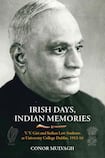
Between 1913 and 1916 there was an influx of Indian students who came to Dublin to study. Many were Indian nationalists, who saw in Ireland a parallel situation to their own country. Varahagira Giri was one of them. He would later serve as President of an independent India from 1968 until 1974. He witnessed the Lockout, became interested in the Irish independence movement, lived through the Easter Rising and was deported shortly afterwards back to India. He always maintained that his Irish experience marked him, not least because he always claimed (with little or no evidence to back it up) that his tutor at UCD had been Thomas MacDonagh. So much so that when British prime minister Ted Heath invited him to Britain, Giri replied that he would be delighted to “drop into” London to see him on his way to Ireland.
The author, a lecturer at UCD, has written a historical and somewhat anecdotal exposition of the story of Indian students in what was then a very homogeneous Dublin. Giri studied law at the Kings Inns and arts at UCD during his time in Dublin. There are comparisons in the book of the Irish and Indian struggles for independence. Initially, some Indian students were open to physical force methods to achieve independence but later came more under the influence of Gandhi.
Perhaps the most interesting aspect of the book is the somewhat far-fetched theory of a tenuous connection to one of the executions in 1916. Indian students were being vilified in a cheap Dublin scandal sheet called Eye-Opener, edited by a man called Thomas Dickson, a unionist. After seeing themselves described as “the Black Peril” and “vampires”, Indian students were upset and made complaints. The author thinks that it may be possible that these complaints may have led to Dickson’s undoing, perhaps by his coming to the notice of the authorities under the Defence of the Realm regulations. In any case, after arresting him on Tuesday of Easter Week, the crazed British officer, Captain JC Bowen-Colthurst, ordered the following day that Dickson be shot by firing squad in Portobello Barracks. Also ordered executed were the person whom the author conjectures Dickson may have been meeting about the Indian students, Patrick McIntyre, and, of course, Francis Sheehy-Skeffington, who had nothing to do with either of them.
This is a short book that could have been much shorter as there is no evidence for many of the claims that Giri made, including, “was regularly invited to [Irish] Citizen Army meetings” The author also notes that Giri claimed that he “became close to James Connolly”. The author doesn’t provide any documentary evidence that MacDonagh was his lecturer or tutor. However, it is very likely that they did meet and talk, as UCD, then at Earlsfort Terrace, was a small enough place and MacDonagh, by all accounts, was an extremely approachable individual. There is no official record of Giri’s deportation order, either.
People interested in Indian-Irish relations may enjoy this book.










